From the August 2016 issue of GCM magazine:
Managing billbugs in the Intermountain West
Scientists are learning more about billbugs in Utah, and new insecticides offer control of these pests on golf courses.
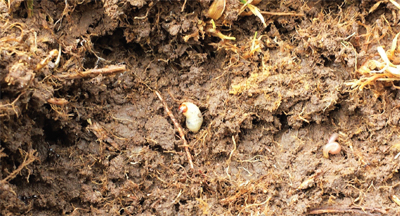
Billbug larvae lack legs, which distinguishes them from white grubs. However, there are no characteristics that allow
visual identification of billbug larvae to species.
Photos by Adam Van Dyke
Adam Van Dyke, M.S., CPAg
Read this story in GCM's digital edition »
While turf scientists and managers in the northeastern United States are furiously battling the annual bluegrass weevil (or Hyperodes weevil) (Coleoptera: Curculionidae: Listronotus maculicollis), those in the Intermountain West region are making strides to understand its relative: billbugs (Coleoptera: Curculionidae: Sphenophorus species). Billbugs belong to the weevil complex and have been a serious turf pest since the late 1960s (10). Their biology and management with insecticides has been extensively studied in the eastern U.S. (4,5,6,11), but such information is scant for billbug species in the western United States. Utah superintendents recently identified billbugs as one of the most problematic insect pests of golf turf (3), but a lack of information about billbug biology and phenology in the Intermountain West has hampered superintendents’ ability to manage them with insecticides — until now.
Billbug distribution in the U.S.
There are 64 species of Sphenophorus in North America (71 worldwide), and the majority of them use wild grasses and sedges or grain crops as hosts (5). Only 10 species are known to damage turfgrasses (11). The most commonly known billbugs across the U.S. are the bluegrass billbug (S. parvulus Gyllenhal) and hunting billbug (or zoysia billbug) (S. venatus vestitus Chittenden). In general, bluegrass billbugs are most prevalent in northern areas and prefer cool-season grasses as hosts. Hunting billbugs, on the other hand, are dominant in the South, where warm-season grasses grow.
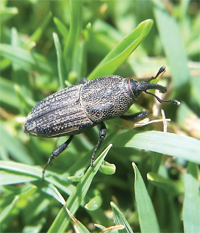 |
|
Bluegrass billbug (Sphenophorus parvulus Gyllenhal).
|
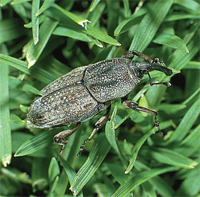 |
|
Hunting or zoysia billbug (S. venatus vestitus Chittenden).
Photos by Dave Shetlar
|
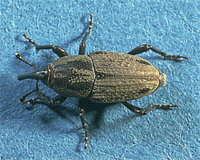 |
|
Phoenician or Phoenix billbug (S. phoeniciensis Chittenden).
|
Billbug distribution is not confined to regional boundaries within the U.S., however. Just as different turfgrasses are adapted to multiple regions, these two species are often found cohabitating with other less common billbug species (8), using a range of grass hosts. The most recent review of literature for the geographic distribution of turf-damaging billbug species in the U.S. (2) has identified four species in Utah (in descending order of abundance): bluegrass billbug, hunting billbug, Rocky Mountain billbug (or Denver billbug) (S. cicatristriatus Fabraeus), and Phoenician billbug (or Phoenix billbug) (S. phoeniciensis Chittenden). Managing multiple billbug species in turf is more challenging because of differences in the insects’ biology and phenology.
Identification and biology
Billbug larvae are legless with cream-colored bodies and a brown head capsule. Because they are legless, billbug larvae are easily distinguished from white grubs (Coleoptera: Scarabaeidae) in turf, but among Sphenophorus, there are no external characteristics to identify larvae to species. At first, pupae are the same cream color as the larvae, but they later sclerotize and darken to red-brown or black, with the characteristic weevil snout evident. Experts can identify pupae to species by the length of the snout and the width of the pronotum (the area behind the head) (9), but the most reliable way to identify Sphenophorus to species is by differences in adult pronotal patterns, markings on elytra (wing covers), color, and relative size of adults (9).
Adult billbugs have typical weevil characteristics: a curved snout in front of the head, clubbed and elbowed antennae rising from the base of the snout, and hard wing covers. The bluegrass billbug is generally the smallest (0.28 to 0.3 inch [7 to 8 mm]) and is black-gray in color, with numerous fine punctures on the pronotum. Sometimes the bluegrass billbug has a medial ridge, without punctures, on the pronotum. The hunting billbug in usually slightly bigger (0.3 to 0.4 inch [8 to 11 mm]) with a raised “Y” in parentheses — (Y) — on each side. Hunting billbugs can vary considerably in color, from dark red-brown to almost black. Rocky Mountain billbugs are the largest (0.4 to 0.47 inch [10 to 12 mm]). Their bodies have the appearance of black leather, with small, even dimples on the pronotum, and deep punctures that form a heart or a hoof pattern on the elytra. The Phoenician billbug is smaller than the hunting billbug and has a raised, smooth “M” on the pronotum.
Phenology
Adult billbugs emerge from overwintering sites in spring when temperatures begin to increase, and feed by chewing holes in grass stems but cause little damage. However, in the eastern U.S., hunting billbugs may pose more of a threat in the adult stage than once thought (1). Adult emergence varies across the country, with billbugs active as early as February in Utah during some years (Madeleine Dupuy, personal communication).
After mating, female billbugs, which seem to prefer thick, plush stems for oviposition (11), insert eggs into feeding holes in grass stems (4). After 6 to 10 days, eggs hatch into larvae, which go through five instars. Early instars feed inside grass stems, then drop out into the thatch/soil after they have outgrown the stem. The larval stage is generally accepted as the most damaging, and in Utah, the most damaging larval stages seem to occur two to three weeks after peak adult activity. Late instars (third through fifth) feed on roots and crowns from June through August, and then they pupate.
The larval stage lasts 35 to 55 days for the bluegrass billbug compared with 21 to 35 days for the hunting billbug (12). Pupation takes longer for bluegrass billbugs (8 to 12 days) compared with hunting billbugs (3 to 7 days) before they emerge as new adults (4).
When new adults emerge in fall, they maintain themselves by periodically feeding at the bases of grass stems (9) before seeking out protected areas to overwinter, such as in plant debris, leaf litter, thatch, soil, hedges, or cracks in hardscape; near foundations or structures of buildings; or in unmanaged areas. In northern climates, most billbugs appear to have a single generation (they are univoltine), but partial second generations can occur for certain species (2), and adults and larvae may overwinter together, creating asynchronous populations.
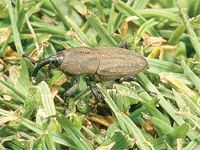 |
|
Bluegrass billbug (S. parvulus Gyllenhal).
|
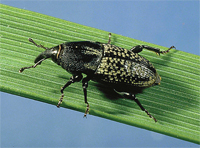 |
|
Rocky Mountain or Denver billbug (S. cicatristriatus Fabraeus).
|
Monitoring adult activity
Adult billbugs are not capable fliers, so their primary mode of movement is walking. Pitfall traps installed at ground level — simple plastic cups to more detailed PVC pipe systems — are effective methods of capturing adults in spring as they emerge from overwintering sites and walk onto managed turf.
Although adult phenological information is useful, it does not accurately predict larval densities or pinpoint where damage may occur. It is, however, helpful in predicting a general period when egg laying is possible — a critical time that precedes hatching in the stem and when billbugs are most susceptible to insecticides.
Damage from billbug larvae is the most misdiagnosed disorder of turf (8) and is often confused with drought or disease. Damage first appears as small yellow, irregular patches in the turf, and it can quickly expand to large areas of brown, dead grass if infestations are large enough. The simple “tug test” can be used where damage is suspected: Turf blades easily pull out or break at the surface, and the broken stems and surrounding thatch or mat may show evidence of sawdust-like excrement (frass). Further scouting by destructively sampling through the thatch and soil for larvae is effective.
Damage thresholds for billbug larvae vary widely from the eastern U.S. (30 to 80/square foot [0.09 square meter]) to the western U.S. (1 to 10/square foot) and are somewhat misleading because high densities may not cause significant damage where turf is healthy. Billbug thresholds are lower in the West because weather patterns create drier conditions in summer when drought stress limits turfgrass from tolerating, or outgrowing, feeding damage. Tolerance of imperfect turf on golf courses is usually low, so insecticides are a standard practice for managing billbugs where they are known to occur. Unfortunately, “damage thresholds” are often the result of later-instar larvae, which are in the crown or soil and therefore more difficult to control than young larvae recently hatched from the egg.
Insecticide management strategies
When using insecticides to control billbugs, superintendents should base the timing of applications on billbug biology. Insecticides may be applied in March or April to target adults as they emerge from overwintering sites into managed turf. To be successful, this approach requires extensive monitoring (as mentioned previously) and precise timing of contact insecticides to the infested turf.
The most effective and most flexible treatments are thought to be preventive applications of systemic insecticides for larvae in May or June. Systemic insecticides are distributed throughout the plant and generally have a longer period of effectiveness than surface-applied contact insecticides. Systemic insecticides are timed to target larvae that are newly hatched from the egg or first instars inside the plant. The active ingredient reaches young larvae inside the stem, but also persists in the root zone and soil and affects older larvae when they begin feeding on roots and crowns. Foraging adults may also feed and be exposed to systemic insecticides at this time.
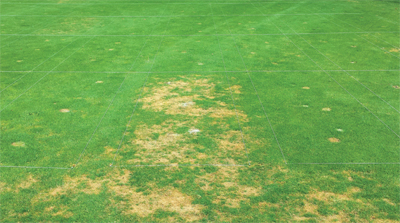
Although adult billbugs cause some damage, larvae are
responsible for more extensive destruction of turf.
Photo by Adam Van Dyke
After damage is evident, curative applications (or “rescue applications”) can be made in July or August to target larger larvae in the thatch, crowns and soil. This timing is the least flexible and takes place when the damage often has already been done. A Purdue Extension publication details more specifics for billbug control at these various timings, including available insecticide options (8).
Because insecticide efficacy data has never been tested or reported in Utah, the objective of this work was to evaluate two newer insecticide options for controlling billbugs by comparing them with a current standard product available for billbug control.
Research
In field research, finding natural populations of turf pests with densities high enough to cause extensive and uniform damage is challenging. Tracking down a location with repeatable insect pressure over multiple years might be considered a miracle, but I was fortunate enough to find such a place in northern Utah, where I conducted four insecticide efficacy trials from 2013 to 2015. The bulk of the insecticide evaluations were based on preventive applications in May, when adults were beginning to lay eggs and before larvae were present. Trials were conducted on a golf course fairway in 2013, 2014 and 2015, and on a lawn in 2013.
Neonicotinoids (imidacloprid, thiamethoxam, clothianidin) have been the industry standard for preventive applications that control billbug larvae, but in some areas, neonicotinoid use is restricted.
Two new alternatives to neonicotinoids for billbug control are the anthranilic diamides Acelepryn (chlorantraniliprole, Syngenta) and Ference (cyantraniliprole, Syngenta). These products belong to a newly developed class of insecticides (IRAC Group 28), are systemic, and are taken up by the plant foliage and roots. These materials selectively activate insect ryanodine receptors, thereby causing mortality from the uncontrolled release of calcium ions in muscle cells, which causes paralysis. Acelepryn was registered for turf in 2008, and Ference was registered in 2014.
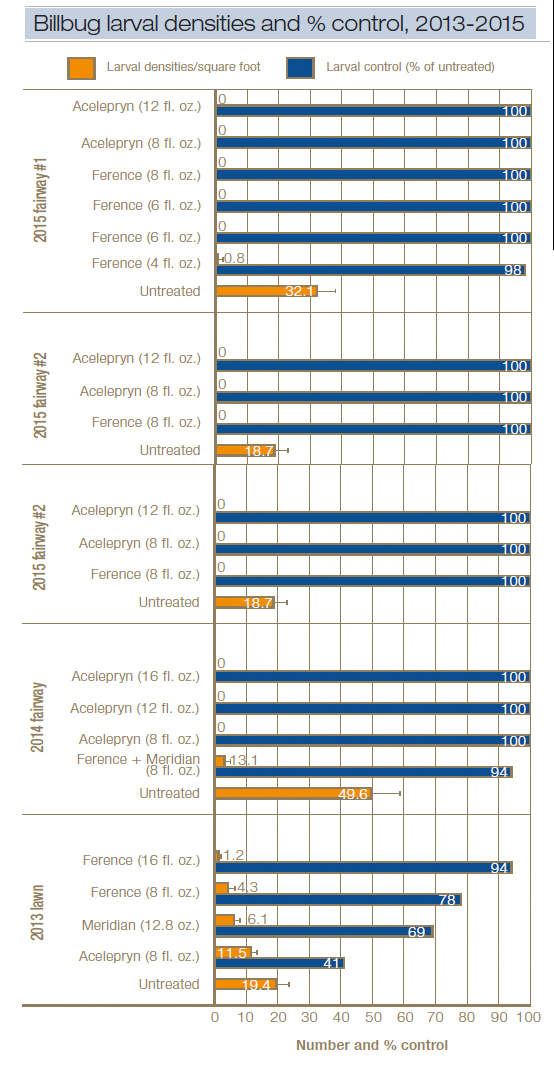
Figure 1. Number of billbug larvae (per square foot) and corresponding control (comparing insecticide-treated turf numbers to those of untreated turf) for insecticide treatments tested over three years (2013-2015) and in four different trials in northern Utah. Error bars associated with the larval means show differences between treatments in each trial at a 95% confidence interval. Amounts of insecticide are in fluid ounces or dry ounces/acre. Acelepryn and Ference applications provided excellent control of billbug larvae in fairway turf with densities as high as 32 to 50/square foot.
General methods
Adult activity was tracked each year with pitfall traps installed near each trial. This information was useful for determining when to make applications that targeted the egg-laying stage, or when adult activity was increasing.
Insecticide treatments were applied in May of each year with a backpack sprayer operating at 40 psi (275.8 kPa) through a boom with four TeeJet AI11002VS nozzles delivering 2 gallons/1,000 square feet (87 gallons/acre; 814 liters/hectare). Treatments were applied to 4-foot-by-10-foot (1.2-meter-by-3-meter) plots arranged in a randomized complete block and replicated five times. Insecticide treatments were not watered in for at least 24 hours after application, providing time for translaminar uptake of insecticides to occur.
Fairway turf was predominantly annual bluegrass (Poa annua L.) with some perennial ryegrass (Lolium perenne L.) and Kentucky bluegrass (P. pratensis L.) mowed at 0.6 inch (15 mm) three days each week. Fertility included 2 to 3 pounds of granular nitrogen per 1,000 square feet (9.76 to 14.65 grams/square meter) each year, and turf was irrigated each night to replace 70% of reference evapotranspiration (ETo). The soil was sand (93% sand, 6% clay, 1% silt) with a pH of 7.6 to 8.2, 1% to 4% organic matter, and minimal thatch (<¼ inch [6 mm]).
Billbug control was measured by larval counts and visual damage estimates. Larvae were counted in July (multiple times in 2013 and 2014, and a single assessment in 2015) from three to five 3.5-inch-diameter (9-cm-diameter) cup cutter plugs (depending on trial and year) pulled from each plot. The number of larvae per sampled area was converted to number per square foot for standardization across trials and years. Calculations that compared larval means of treated turf with those of untreated turf were done to determine percent control.
Turf damage was visually rated on a scale of 0% to 100% in June, July and August each year. Turf quality was also rated using a 1-9 scale, where 9 is the best, 6 is acceptable, and 1 is dead turf. Phytotoxicity was also monitored after each application.
2013 methods and results
Methods specific to 2013 trials
The first year of testing began with three major questions: What species of billbugs are in Utah? What kind of population densities are present? Are there multiple generations of billbugs? Therefore, two identical trials were conducted — one at the golf course, and another on a nearby lawn with a history of billbug damage. The lawn differed from the golf course site in several respects. The lawn was Kentucky bluegrass mowed at 3 inches (76 mm) only once each week; it received less fertilizer (1 to 2 pounds nitrogen/1,000 square feet/year [4.88 to 9.76 grams/square meter/year]) and less irrigation (70% ETo replaced every 3 to 4 days); and the soil was silt loam (37% sand, 26% clay, 36% silt) with more thatch (¾ inch to 1 inch [19 to 25 mm]).
Without having a clear understanding of billbug biology for the region, two application timings were assessed in the 2013 trials and multiple larval counts were taken. The first timing was preventive insecticide treatments applied on May 17 (the A-app) and included Acelepryn 1.67SC at 8 fluid ounces/acre (0.58 liter/hectare); Ference 1.67SC at two rates, 8 and 16 fluid ounces/acre (0.58 and 1.17 liters/hectare); and Meridian 25WG at 12.8 ounces/acre (0.90 kilogram/hectare). To target potential second-generation billbugs, multiple applications of Ference 1.67SC at 8 fluid ounces/acre were made on May 17 and again on July 1 (the B-app).
Although all treatments were applied at both locations in 2013, larvae were only counted at the lawn site because of high insect pressure. Larvae were assessed at initiation on May 17 (0 days after the A-app); then again on June 17 (30 days after the A-app); July 1 (45 days after the A-app; 0 days after the B-app); July 31 (60 days after the A-app; 30 days after the B-app); and Aug. 13 (90 days after the A-app; 60 days after the B-app). Visual turf damage and quality ratings were made at both sites.
2013 trial results
As mentioned previously, adult catches in pitfall traps showed that bluegrass billbug is the dominant species in northern Utah, followed by hunting billbug and then Rocky Mountain billbug. Adult activity for both bluegrass and hunting billbugs peaked in early June 2013. An earlier but smaller increase in activity from both species occurred in mid-May. Adult Rocky Mountain billbugs were active all year, with low numbers and no apparent peak (Madeleine Dupuy, personal communication).
No billbug larvae were found in either trial in May, and only a few were found in June 2013. Two to three weeks after adult activity peaked in June, 19 larvae/square foot were found in untreated turf on July 1 (Figure 1). Very few larvae were found in August, and this, along with a decline in adult captures in fall, suggests the majority of billbugs in Utah have a single generation.
Ference (78% to 94%) was better at controlling billbug larvae than Meridian (69%) and Acelepryn (41%) in lawn-height turf in 2013 (Figure 1). The thick thatch layer may have negatively influenced the performance of Acelepryn, because it is not as water-soluble as Ference or Meridian. The higher label rate of Ference (16 fluid ounces/acre) gave better control than the lower rate (8 fluid ounces/acre). Follow-up applications of Ference in July likely had little impact on larval densities, because few larvae were present and larvae caused no turf injury in August.
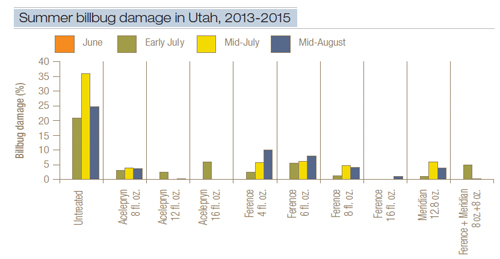
Figure 2. Billbug damage to turfgrass by month, as averaged across multiple years (2013-2015) and trials for similar treatments, for untreated and insecticide-treated turf in northern Utah. Amounts of insecticide are in fluid ounces or dry ounces/acre. See the results section for each year for more specific information on treatments and damage. Acelepryn and Ference applications kept billbug damage to turfgrass below 10% in summer, but untreated turf was severely damaged.
Although control of billbug larvae from Meridian and Acelepryn did not reach a desired target of >90% reduction in density in the lawn trial, larvae were affected by these insecticides, as billbug damage was minimal (<5%) in summer (Figure 2). The lawn turf also recovered more quickly in fall when treated with insecticides, whereas untreated turf did not fully recover. There was more damage in Meridian-treated fairway turf than in the lawn turf in 2013, highlighting how soil type and/or management input differences between sites can influence insecticide efficacy (data not shown).
2014 methods and results
Methods specific to 2014 trial
Preventive insecticide treatments were applied on May 5 to fairway turf. Treatments included Acelepryn 1.67SC at three rates (8 fluid ounces/acre, 12 fluid ounces/acre [0.88 liter/hectare], and 16 fluid ounces/acre), and a combination of Ference 1.67SC (8 fluid ounces/acre) mixed with Meridian 25WG (8 ounces/acre [0.56 kilogram/hectare]).
2014 trial results
Untreated turf averaged 50 billbug larvae/square foot (Figure 1), and 20% of the turf area had been damaged by July 1 (Figure 2). Larval density decreased to 25/square foot July 22, with 50% of the turf being damaged (data not shown). In comparison, all insecticide-treated turf had fewer than 2 billbug larvae/square foot with <6% visible turf damage. The combination of Ference + Meridian did not control larvae as well as Acelepryn in July, but still limited feeding damage. Preventive applications of Acelepryn at all rates in May provided compete control of billbug larvae in summer. All insecticide treatments were safe and provided excellent-quality turf on the cool-season fairway (Figure 3).
2015 methods and results
Methods specific to 2015 trials
Two trials with nearly identical treatments were conducted on different fairways in 2015. Preventive treatments for larvae were applied on May 13 and included two rates of Acelepryn 1.67SC (8 and 12 fluid ounces/acre), and two rates of Ference 1.67SC (6 and 8 fluid ounces/acre [0.44 and 0.58 liter/hectare]). In just one of the trials, larval curative treatments were applied June 5, targeting early larval stages with Ference at 4 and 6 fluid ounces/acre (0.29 and 0.44 liter/hectare).
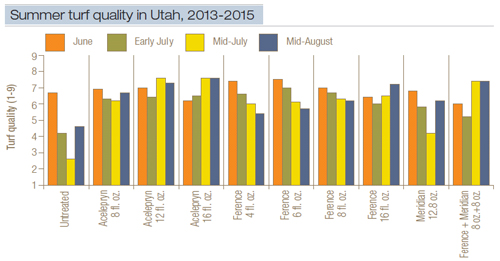
Figure 3. Turfgrass quality by month for untreated and insecticide-treated turf in northern Utah. Quality means are averaged across multiple years (2013-2015) and trials for similar treatments. Amounts of insecticide are in fluid ounces or dry ounces/acre. See the results sections for more information. Acelepryn and Ference (applied at high label rates) provided acceptable turf quality throughout summer. Untreated turf suffered greater billbug damage and therefore had lower turf quality.
2015 trial results
One fairway site averaged 19 billbug larvae/square foot in untreated turf in July. The other fairway averaged 32 billbug larvae/square foot (Figure 1) and an average of 17 black turfgrass ataenius (Coleoptera: Scarabaeidae: Ataenius spretulus Haldeman)/square foot (data not shown). Not surprisingly, turf damage was greatest on the fairway where higher billbug densities and black turfgrass ataenius were found, but very little damage could be seen on the fairway with 19 larvae/square foot (data not shown).
Turf treated with Acelepryn had no billbug larvae and <2% damage, regardless of rate, in both trials (Figures 1,2). Ference controlled >98% of billbug larvae across a range of application rates (4 to 8 fluid ounces/acre) and timings (mid-May or early June), which resulted in less than 5% damage to turf in July (Figures 1,2). However, turf treated with 4 fluid ounces/acre of Ference in June had some breakthrough of black turfgrass ataenius, as only 78% were controlled in July, which resulted in slightly more turf damage in August (Figure 2). In 2015, Acelepryn and Ference applications were safe on fairway-height annual bluegrass, providing good turf quality (Figure 3).
Additional field observations
The first attempts at larval curative treatments in 2015 with Ference were likely made too early, as adults peaked a little later in 2015 than they did in 2014 (data not shown). Trials in 2016 will include treatments targeting early-July applications, which is when, historically, turf damage begins and larvae densities peak.
Summary and discussion
To date, four billbug species have been confirmed in Utah (2). According to work by researchers at Utah State University (7), predictive degree-day models from the eastern U.S. (12) do not fit billbug trap-catch data from the Intermountain West. The eastern model predicts first adult activity in spring at 155-195 DDbase 10 C (degree days, base 10 C [50 F]), but trap catches in Utah have occurred several weeks earlier (0-15 DDbase 10 C). This new phenological data, coupled with the promising new chemical options presented here, should increase precision and success of billbug management in the West.
The anthranilic diamides, Acelepryn and Ference, have provided excellent and repeatable control of billbugs in northern Utah (Figure 1). Applications at various labeled rates in spring have resulted in excellent turf quality and safety (Figure 3). Applying Acelepryn at 8 to 12 fluid ounces/acre around peak adult activity has controlled >90% of billbugs in fairways, and Ference at 6 to 8 fluid ounces/acre has been statistically similar (Figure 1). However, the two insecticides have important differences that need to be understood.
The success of Acelepryn depends on making applications early enough for the material to get absorbed into the plant. We have not studied early summer (June) applications with Acelepryn because it is not expected to translocate through the plant in time in order to achieve biological activity on later-instar larvae. Success in these golf course trials over multiple years might be due to great application timing, plus almost perfect site conditions of sandy soil, minimal thatch, and low organic matter that has optimized plant uptake and protection from the product. Higher rates may be needed in turf with different species compositions and management, or where soil textures are heavier or thatch is thicker.
Ference has a higher solubility than Acelepryn, so application rates of Ference are likely more important to consider depending on when it will be applied. Ference applied in May or June at 6 to 8 fluid ounces/acre has shown excellent billbug control, but lower rates of 4 fluid ounces/acre may not be as effective for billbugs, and certainly were not as efficacious on black turfgrass ataenius larvae. Ference has also been effective when mixed with neonicotinoids such as Meridian, but the combination has not been as effective as Acelepryn alone. Bottom line: Anthranilic diamides provide new tools to help in managing billbugs and are another option where neonicotinoid use is restricted.
Funding
Funding for this research was provided by Syngenta Crop Protection.
Acknowledgments
A special thanks to superintendent Paul Stokes for letting billbugs ravage his golf course so we could study them, and Utah State University Ph.D. candidate Madeleine Dupuy for providing adult capture data. Thanks also to Syngenta Crop Protection’s Dean Mosdell, Ph.D., technical manager, and David L. Cox, Ph.D., field science expert for the western United States, for reviewing the paper for accuracy.
Literature cited
- Doskocil, J.P., and R.L. Brandenburg. 2012. Hunting billbug (Coleoptera: Curculionidae) life cycle and damaging life stage in North Carolina, with notes on other billbug species abundance. Journal of Economic Entomology 105(6):2045-2051.
- Dupuy, M.M., and R.A. Ramirez. 2016. Biology and management of billbugs (Coleoptera: Curculionidae) in turfgrass. Journal of Integrated Pest Management 7(1):1-10.
- Johnson, P.G., A. Van Dyke, E. Hodgson et al. 2012. Interest, incentives and education towards organic golf course management: A study of Utah golf course superintendents. Applied Turfgrass Science 9(1):1-9.
- Johnson-Cicalese, J.M., G.W. Wolfe and C.R. Funk. 1990. Biology, distribution, and taxonomy of billbug turf pests (Coleoptera: Curculionidae). Environmental Entomology 19:1037-1046.
- Niemcyzk, H.D., and D.J. Shetlar. 2000. Destructive turf insects. 2nd ed. H.D.N. Books, Wooster, Ohio.
- Potter, D.A., and S.K. Braman. 1991. Ecology and management of turfgrass insects. Annual Review of Entomology 36:383-406.
- Ramirez, R., and M. Dupuy. 2015. Kill billbug: Improving a predictive model to time management in the Intermountain West. Entomological Society of America, ASA, CSSA and SSSA Annual Meeting. Minneapolis, Minn.
- Richmond, D. 2015. Managing billbugs in turfgrass. Turfgrass Insects. Purdue Extension Publication E-266.
- Shetlar, D.J., D. Silcox and T.J. Gibb. 2012. Billbugs. Pages 16-18. In: R.L. Brandenburg and C.P. Freeman, eds. Handbook of Turfgrass Insects. 2nd ed. The Entomological Society of America, St. Paul, Minn.
- 10.Tashiro, H., and K.E. Personius. 1970. Current status of the bluegrass billbug and its control in western New York home lawns. Journal of Economic Entomology 63(1):23-29.
- 11.Vittum, P.J., M.G. Villani and H. Tashiro. 1999. Turfgrass insects of the United States and Canada. 2nd ed. Cornell University Press, Ithaca, N.Y.
- 12.Watschke, T.L., P.H. Dernoeden and D.J. Shetlar. 2013. Managing turfgrass pests. 2nd ed. CRC Press, Boca Raton, Fla.
Adam Van Dyke is the owner and field scientist of Professional Turfgrass Solutions LLC, Salt Lake City, Utah.